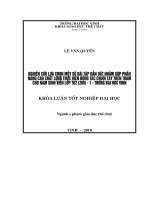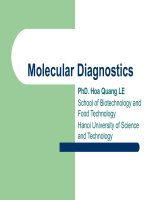Molecular Diagnostics (Phân tích nhanh chất lượng thực phẩm)
Bạn đang xem bản rút gọn của tài liệu. Xem và tải ngay bản đầy đủ của tài liệu tại đây (5.44 MB, 142 trang )
Molecular Diagnostics
PhD. Hoa Quang LE
School of Biotechnology and
Food Technology
Hanoi University of Science
and Technology
Some success stories
Glucose sensor
→ Diabetic patients can monitor blood glucose at home
Glucose sensor
Pregnancy testing
Pregnancy testing
Human chorionic gonadotropin (hCG) is a glycopeptide
hormone produced by the placenta during pregnancy.
The appearance and rapid rise in the concentration of
hCG in the woman's urine makes it a good pregnancy
marker.
Usually, concentration of hCG in urine is at least 25
mIU/ml as early as seven to ten days after conception.
The concentration increases steadily and reaches its
maximum between the eighth and eleventh weeks of
pregnancy.
Pregnancy testing
Molecular diagnostics
Diagnosis of infectious diseases
Diagnosis of genetic diseases
Genetic identification
Characteristics of a detection system
A good detection system should at least have 3 qualities:
•
Sensitivity
•
Specificity
•
Simplicity
Sensitivity means that the test must be able to detect
very small amounts of target even in the presence of
other molecules.
Specificity: the test yields a positive result for the
target molecule only.
Simplicity: the test must be able to run efficiently and
inexpensively on a routine basis.
Diagnosis of infectious diseases
Viruses (HIV, HBV, HCV…)
Bacteria (Vibrio cholerae, Mycobacterium tuberculosis…)
Fungi (Aspergillus, Candida)
Diagnosis of infectious diseases
Culture methods
Immunological methods (antigen detection, antibody
detection): specific interactions between antibody and
antigen
Nucleic acid-based methods (PCR, NASBA, LAMP):
specific binding between DNA or RNA molecules
Culture methods
Use media for isolation and identification of pathogenic
organisms. Useful for antimicrobial sensitivity test.
Different types of media:
•
Enriched media: high nutritive value to promote growth
•
Selective media: allow only needed bacteria to growth
•
Indicator media: to distinguish one microorganism type
from another growing on the same media
Culture methods
Evaluation based on:
•
Colony morphology (shape, size, color, edge of colony)
•
Pigment production
•
Hemolytic activity
•
Plaque formation, cytopathic effect for virus
Culture methods
Advantages: gold standard method
Disadvantages: laborious, time-consuming, need of
special facilities, risk of infection…
Culture methods
Blood-free, charcoal-based selective medium agar for isolation of
Campylobacter
Culture methods
Blood agar plates are often used to diagnose infection. On the
right is a positive Streptococcus culture; on the left a positive
Staphylococcus culture.
Culture methods
Viral Plaques of Herpes Simplex Virus
IMMUNOLOGICAL METHODS
Microbial antigen detection → direct evidence of infection
Antibody detection → indirect evidence of infection
However, not all infectious agents have available antigen
assay → detection specific antibodies is useful
Antigen or antibody detection?
Immune system: a quick overview
Analysis of HBV infection
Analysis of HBV infection
Assay)
ELISA involves:
•
the reaction of an antibody with an antigen and a
detection system to determine if a reaction has
occurred.
•
binding of the test molecule or organism to a solid
support (e.g. micro titer plate).
ELISA to detect antigen
capture antibody, directed against
antigenic protein, is linked to a solid support
clinical sample is added, the antigen, if
present, will be capture by the bound antibody
washing to remove unbound molecules
addition of second antibody which will be bind to the antigen. This
antibody is linked to an enzyme
washing to remove unbound molecules
addition of a colorless substrate → color product → positive result









